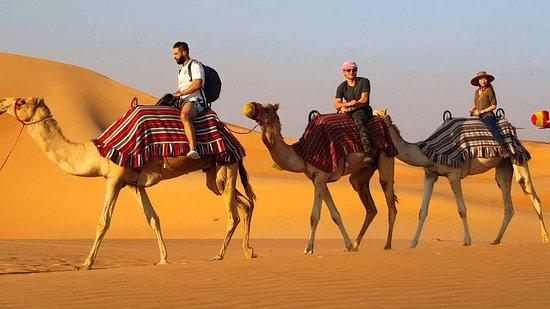When you think of the UAE’s desert landscape, one of the first images that comes to mind is a camel crossing the golden dunes. In Abu Dhabi, camel riding is far more than a tourist activity — it’s a tradition that reflects centuries of Bedouin history, survival, and pride. From ancient trade routes to modern desert safaris, this iconic animal has remained a symbol of endurance, identity, and cultural heritage.
Camels in Emirati History
For the Bedouins, camels were once the only reliable means of transportation across the harsh desert terrain. These animals were prized not just for their strength and resilience but also for their ability to provide milk, wool, and even meat. Camels served as lifelines in a region where resources were scarce. In many ways, they shaped how communities developed and survived in the vast deserts of what is now the UAE.
Camel Riding as a Traditional Skill
Camel riding was once a daily necessity, passed down through generations. Learning how to mount, control, and ride a camel was an essential life skill for desert dwellers. It wasn’t just a form of travel, but a rite of passage for many young Emiratis growing up in nomadic communities. Today, while no longer a practical necessity, camel riding is taught and preserved to honor that heritage.
Importance in Modern Emirati Culture
In today’s Abu Dhabi, camel riding is still celebrated through events like camel races and cultural festivals. These gatherings bring people together to witness the agility and strength of camels in action. Camel beauty contests are also a part of Emirati tradition, where the animals are judged for their features, lineage, and posture — highlighting the continued reverence for camels in local society.
How Camel Riding Reflects Emirati Hospitality
When visitors participate in camel rides during a desert safari in Abu Dhabi, it often includes elements of traditional hospitality. Tourists may be welcomed with dates, Arabic coffee, and storytelling, offering a glimpse into the warmth and generosity that Bedouin communities have practiced for centuries. The camel ride itself becomes a gateway to understanding deeper cultural values.
Camel Rides and Storytelling Traditions
Oral storytelling, once an essential part of Bedouin culture, often featured tales of desert journeys, survival, and camel treks across vast dunes. These stories were shared around campfires, teaching lessons about respect for nature, resilience, and wisdom. Today’s guided camel tours sometimes incorporate these narratives, making the experience both immersive and educational.
Preserving Heritage Through Desert Tourism
The UAE government and local tour providers have made significant efforts to ensure that camel riding remains an authentic and respectful cultural practice. Regulations are in place to ensure ethical treatment of animals, and many tours are led by local guides who share first-hand knowledge of desert traditions. These tours don’t just entertain — they help keep a unique cultural identity alive for future generations.
Environmental Connection of Camel Travel
Unlike modern vehicles that disturb the natural desert ecosystem, camels tread lightly on sand and leave minimal environmental impact. Historically, this allowed communities to travel without damaging fragile desert flora. In modern times, this gentle approach continues to resonate with eco-conscious travelers who wish to experience nature without disrupting it.
Camel Riding in Festivals and Celebrations
Events such as the Al Dhafra Festival and the Liwa Date Festival often feature camel parades, races, and exhibitions that attract visitors from around the world. These events serve as both celebration and preservation, blending traditional arts, music, and camel activities in one place. Participating in these events offers tourists a unique perspective on the role camels play in national pride.
Why Tourists Are Drawn to the Experience
Visitors to Abu Dhabi seek more than just a ride — they’re looking for a meaningful connection with Emirati culture. Riding a camel through the desert at sunrise or sunset, under endless skies and surrounded by silence, offers a moment of reflection. It becomes a rare chance to walk — or ride — in the footsteps of those who shaped the land centuries ago.
Common FAQs About Camel Riding in Abu Dhabi
Is camel riding safe for first-time riders?
Yes, camel rides are generally safe. Professional handlers guide the experience, and safety measures are in place, especially on tours geared toward families or first-time riders.
How long does a typical camel ride last?
Most camel rides on desert safaris last between 15 to 45 minutes. However, longer rides can be arranged through certain tour packages for a deeper experience.
Do I need to wear specific clothing?
Loose, breathable clothes are recommended, along with closed-toe shoes. Sunglasses, hats, and sunscreen are useful due to the strong desert sun.
Are camel rides ethical in Abu Dhabi?
Reputable tour operators follow ethical practices to ensure camel welfare. Look for providers that prioritize animal care, limit ride durations, and avoid overworking the animals.
Is camel riding suitable for kids or elderly people?
Yes, though it depends on individual health and mobility. Most safari operators offer guidance and assistance to make the experience comfortable for all ages.
Can camel riding be part of an overnight safari?
Absolutely. Many overnight desert safaris in Abu Dhabi include camel rides along with dinner, entertainment, and traditional camp stays.
Conclusion: Riding with Respect
Camel riding in Abu Dhabi is not just about leisure. It’s a bridge to a culture that once thrived on sand and tradition. By choosing to ride a camel during your visit, you’re participating in a living history — one that continues to breathe through every step of these incredible animals. When done respectfully and responsibly, the experience can be as enriching for the traveler as it is for the legacy of the desert.



